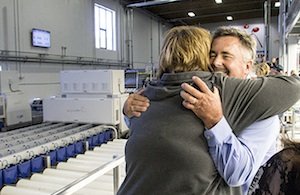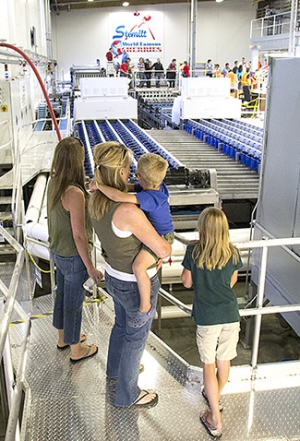
Kyle Mathison, an owner of Stemilt Growers, Inc., Wenatchee, hugs guests as they arrive to see the company’s new cherry packing line.
Washington’s fresh cherry crop, which was affected by poor pollination, took another hit with rains in late May that affected the early maturing cherries. As a result, the shipping season is getting off to a slow start, and the latest estimate of the Northwest cherry crop is 17.3 million boxes, down 25 percent from the record 2012 crop.
“It was a double whammy,” said Roger Pepperl, Stemilt’s marketing director, who expects cherry volumes will be light until July when harvest picks up in some of the later districts. Stemilt will likely pack cherries through the first week of September. The company has cherry lines at four other facilities also.
Although Stemilt expects to pack only 2 million boxes of cherries this season, compared with a typical 3.4 million boxes, the addition of the new cherry line is auspicious because it features the latest technology in electronic sorting, making it easier to remove low-quality cherries and deliver a consistent pack to the buyer. The company, which did not disclose the size of its investment in the new line, also hopes it will help improve returns to the orchard, through better sizing and sorting, while reducing sorting costs.
The line, from GP Graders in Australia, can handle 10 tons of cherries per hour, or 18 million cherries a day with a double shift. An additional two to three tons of undersize cherries can be diverted from the line to be sorted manually, rather than electronically.
 The line, which is designed to handle the fruit gently, has two banks of cluster cutters and more singulators than is standard. This helps space out the cherries as they go into cups and through the electronic sorter. Images are taken of each cherry to determine its color and size and check for internal and external defects. Depending on how they’re graded, the cherries are air-ejected into flumes and deposited onto one of 20 packing belts or diverted into the cull shoot. The cherries are packaged in boxes, bags, or clamshells, and the line has the capacity to pack up to 80 percent of the cherries into clamshells.
The line, which is designed to handle the fruit gently, has two banks of cluster cutters and more singulators than is standard. This helps space out the cherries as they go into cups and through the electronic sorter. Images are taken of each cherry to determine its color and size and check for internal and external defects. Depending on how they’re graded, the cherries are air-ejected into flumes and deposited onto one of 20 packing belts or diverted into the cull shoot. The cherries are packaged in boxes, bags, or clamshells, and the line has the capacity to pack up to 80 percent of the cherries into clamshells.
The company is experimenting with blow drying cherries before they go into the boxes in an effort to reduce moisture in the boxes and the risk of decay in cherries going to distant markets.
Van Doren Sales of East Wenatchee provided the dump tank and elevator, and installed some of the conveyors for the line.
The line takes up exactly half of a former storage room at the Euclid Avenue facility. There are plans to build a twin line in the other half, perhaps in 2016, said Jay Fulbright, vice president of operations.
First crop
West Mathison, president of Stemilt, said the opening of the company’s new line took place exactly 100 years after his great-great-grandfather Thomas Cyle Mathison harvested his first cherry crop at Stemilt Hill, where he came to homestead in 1893.
The orchard was passed down to Thomas’s son Chris and then Chris’s son Thomas Kyle “TK” Mathison, who suffered through some difficult times in the cherry industry in the 1950s. Frustrated by the quality of cherries when they reached the markets, TK founded his own packing company, Stemilt Growers, in 1964 to ensure that his fruit reached the market in the best condition.
“TK started Stemilt with a passion to improve the dessert eating experience of the fruit, and he did just that,” West said during the dedication of the line. The cherry industry today barely resembles that of 50 years ago, when Stemilt Growers began, he noted, but the passionate pursuit of quality still directs the company today.
Kyle Mathison, TK’s son, said the new line would help the company deliver a consistent product that would build consumer demand.
“World Famous Fruit is not a destination, it’s a journey,” he said, referring to Stemilt’s logo. “This is part of that journey.”

Leave A Comment